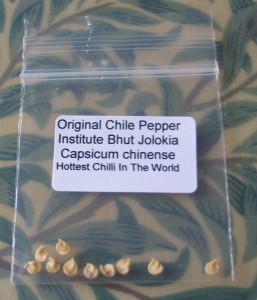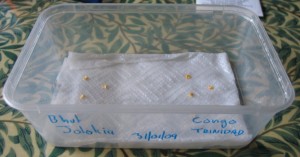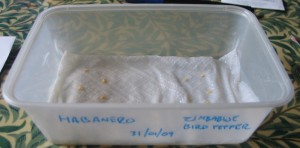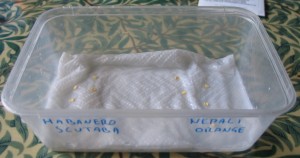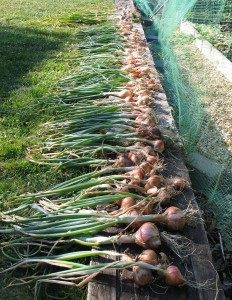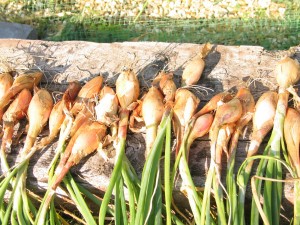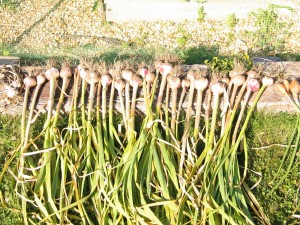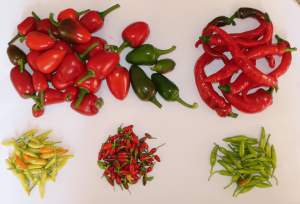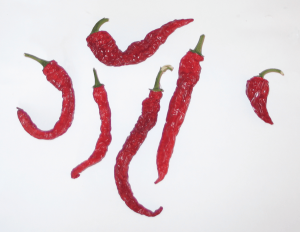OT: Update on The Open Sourcerer’s Chillies
What seems like many moons ago, I posted a brief article about starting this year’s Chilli crop. I “planted” the seeds much earlier than usual (last day of January rather than sometime during March) and I used a different sowing technique to see if the germination could be speeded up. Here’s that first post with a couple of pictures of how I started the seeds off. I said back then that I would also plant some in the more traditional manner, but to be honest I had such excellent results from this trial I did not need to start off any more seedlings at all.
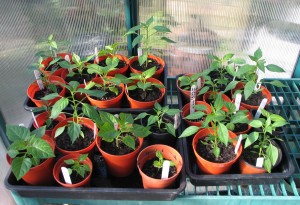
This is how they look now after just 10 weeks. I am delighted with their progress. The germination on soggy toilet paper in the airing cupboard worked really well compared to simply planting the seeds in potting compost. I found that some of the seeds had germinated within a week and most had come up within 2 or 3 weeks. By comparison, pot sown seeds have usually taken anywhere from 4 to 6 weeks to just show.
As soon as the seed started to sprout I carefully cut it, and a small section of the paper it was growing on, from the rest and planted it in a small 3″ pot with regular seed/potting compost. Within 4 weeks all the seedlings were potted on and growing well. Only a few seeds failed to germinate completely, but that is to be expected. I think from 30 odd seeds I have ended up with 23 good strong plants.
Some of the most vigorous have already been potted on into 4″ pots. There are about a dozen still to be done. They all look very healthy and happy (if a plant can actually look happy that is).
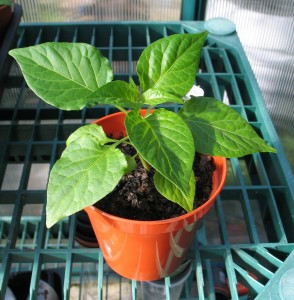
These photos were taken today in our greenhouse. The plants get taken out when the day is sunny and the greenhouse is warm. On cloudy and/or cold days they have remained indoors on a south facing window sill in the living room. By the end of April I will start to harden them off and by mid-May I would expect them to have taken up permanent residence in the greenhouse.
One variety I am especially keen to grow and eat this year is the Naga Bih Jolokia. Here is one of the 4 plants of that variety looking especially radiant. For those who were not aware, the Bih Jolokia has been recorded as the hottest Chilli in the world.
This is the best looking crop of plants, this early on the year, that I have ever grown. I’m now quite hopeful of a good crop this year although a great deal will depend on the sunlight we get through the summer months. But hopefully in a few more months time I’ll have a couple more photos of fruit laden chilli plants to show off!
OT: This year’s first Chillies
As some of you will know I’m a big fan of Chillies. Especially the hot ones and I also really enjoy growing my own too.
For this year’s crop I have decided to start them off quite a bit earlier than I have in the past. It will mean me looking after them for longer until it is warm enough for them to go out to the greenhouse but the extended growing season should help with the yields I hope. So this is a bit of an experiment and I’m going to document it for other budding chilli aficionados.
As you may recall I managed to get some seeds for the Naga Bih Jolokia at the West Dean Chilli Fiesta last summer. Today I have planted the first half of my Naga seeds and some other varieties too.
In addition to planting earlier, I have also decided to try an alternative germination method for half of what i will grow. This method seems popular around some of the forum and – to be honest – it is a technique I used very successfully many years ago as a young man attempting to “grow his own”; if you know what I mean… The other half of the Naga seeds and other varieties I will plant in a more traditional way over the coming weeks.
This alternative technique is easy but different. Rather than dropping your seed into some potting compost in a tray or small pot, the seeds are placed on damp kitchen (or toilet) paper and put into the airing cupboard. Check regularly and keep moist until the seeds germinate (some chillies can take a month or so) and then immediately the seedlings are moved into small pots filled with compost – with a bit of the surrounding paper material- and grown on indoors on a sunny window sill until the weather is warm enough for them to be taken outside during the day into the greenhouse and brought in at night and then, once May (typically) arrives, they can stay out permanently.
Apart from the Naga and the Congo Trinidad varieties, all the the other seed packets were left over from last years season so I hope they will germinate OK:
- The top tray has 5 of the Naga Jolokia seeds and a half dozen of a variety called Congo Trinidad which is an extra large red habanero type and significantly larger and more ribbed than the average red habanero.
- The next tray has a few regular Habanero, a very hot and quite “fruity” chilli, and some Zimbabwe Bird Pepper which are a really small fruit but very fiery. I grew these last year and had a pretty decent crop.
- The final tray has some Habanero Scutaba, a smooth-skinned and flavourful variety of habanero that is more red in colour (normal habanero tend to be more orange), and some Nepali Orange, again a small variety that packs a real punch!
Once things start to happen I’ll drop by with another report and hopefully by mid October this year I’ll have a great crop of very hot chillies…
UK OpenERP Partner Community
Yesterday I had the great pleasure of meeting and chatting with most* of the businesses that are official OpenERP partners here in the UK.
We met at a pub in central London, and talked for around 3hrs. Everyone seemed to get on really well and most of us took the opportunity to share our experiences and promote our individual areas of expertise.
Four of us ended up going for the obligatory curry after the event which was also fun and very enjoyable – especially when the waiter brought me a fresh Naga Chilli to tantalise my taste-buds – hats off to Alan Bell and Chris from Credativ for having a taste of raw Naga. They are definitely NOT for the feint hearted…
The UK partners present at our inaugural meeting yesterday were (in no particular order)
Value Decision
Credativ
Publicus Solutions
Seath Solutions
The Open Learning Centre
A business-minded community of partners represents a much more compelling proposition to our existing and prospective customer-base than do standalone partners.
And here’s a very dodgy picture taken by yours truly:
OT: The Open Sourcerer’s Allium Harvest
As some of you will know, I like my garden and growing stuff, especially chillis. This year’s chilli plants are doing quite nicely in the greenhouse; the small “birds-eye” varieties are looking like they are nearly ready to start picking (I’ve tried a few but they were still immature) and have been quite productive by the looks of it, the habanero varieties will be a couple more months yet I guess.
We are lucky enough to have quite a big garden and we try to grow other veg as well when we have the time, although young kids do tend to restrict the amount we have quite considerably. My darling wife Helen manages to fit more into a day than I and should take most of the credit for our food production. Anyway, we’ve been merrily chomping away on new potatoes (Pentland Javelin) for over a month now and you really can’t eat better when they’re so fresh. We’ve also been eating Broad Beans too which are really tasty and have been a really good cropper along with various salad leaves etc.
Today though was time for the Allium harvest.
Back in February/March planted my favourite shallot, called Longor which is an elongated French style shallot with great flavour and excellent keeping properties (I mean like a year or more!). And we also grew a smaller quantity of the more typical round shallot found in the UK and some Garlic as well. These were all ready to harvest today.
Here’s the results (click the pics for close-ups):
I’m very pleased the quantity of shallots and Garlic this year. All this lot came out of just one of our eight raised beds which are each about 10′ (~3m) long by 4′ (~1.3m) wide.
The Longor is this lovely elongated shallot used extensively in France and elsewhere in Europe but not often seen in supermarkets here. We bought the original sets from the Organic Gardening Catalogue and from each bulb, you normally get between 5 and 8 shallots when they’ve finished growing.
We eat quite a bit of Garlic so the 30 odd bulbs here won’t last us very long but it’s always nice to have grown your own.
All of these plants will be left outside (hopefully) now for a few days to dry off in the sun, or alternatively we’ll put them in the greenhouse if it rains. Once dried they’ll keep for a good while. The Longor Shallot we’ve grown before and it really did keep very well – we were still using them a year after harvest.
Of Alliums in general we have found that they don’t take up much space, are very easy to grow and need little maintenance during their growing cycle. I’d highly recommend them for easy and tasty home-grown produce.
Feel the heat of the Open Sourcerer
OK. Sorry for the bad title but I couldn’t think of a better one.
This is very off-topic but something I really, really love (even more than free software probably): The Chilli. I really get a kick out of hot food and I also enjoy growing them too.
Today, the 11 October, was a sunny warm day for the time of year and it seemed the right day to reap the harvest from my small greenhouse.
I had 6 plants in total grown from seed which were started off in late February. My BW has helped nurture them through our rather damp and grey summer and the results have not been too bad. I have been consuming chilli straight from the plant for the last couple of months and have also given some to friends/family too so, so I am quite pleased with the crop although the harvest wasn’t a large as some years in the past.
The larger round chilli (top left) is an Italian variety my Sister-in-law bought for me last Christmas. What a great present! A tiny pack of seeds and from it I get these really nice peppers. Thick fleshed, good slightly fruity flavour, not too hot [for me at least!]. Perfect for Arrabiata or Piccante sauces with pasta or sliced on Pizza.
The long chilli is the very well known Cayenne (top right). These are typically used to make a great spice powder that is usually known as Cayenne Pepper and this is not the same as regular Chilli Powder. They taste great, not too hot once again, but are great grilled and eaten whole or added, at the last minute, to curries. The plant these chillies came from I actually bought from the Chilli Fiesta at West Dean Gardens. I try to go every year. It’s a chilli lover’s delight and attracts many thousands of visitors in just two days.
The small chilli are all very hot and will be eaten throughout the coming winter in stews, curries and anything else that I can squeeze them into. My family – especially the kids – don’t really like heat that much so it is one of those foods that I mainly get to indulge in all by myself.
Preserving them is pretty easy. The big chillies will be dried in the airing cupboard then stored in a dark place along with all my other spices. Once dried they will keep almost indefinitely it seems.
Here are some I prepared earlier. These have been drying for about a month in the airing cupboard and are now totally bone-dry.
The small chillies I simply washed, cleaned, dried and put into small bags and they have gone in the freezer. This is a great way to keep them. Just take out a few when you need them and by the time you have got from the freezer to the chopping board they have nearly fully defrosted and are almost as good as they were when picked. As these small chillies generally get cooked and are for flavour not texture, the cell damage caused by freezing is not really an issue. Again, they seem to keep almost indefinitely.
If I had had a larger crop, I would have made some Chilli Pickles too. This is a brilliant way of preserving them and is just fantastic in a cheese sandwich. I still have some Chilli Oil Pickle in the cupboard that I made about 15 years ago. It still tastes great too!
Next year I have a real treat in store 🙂
At the Chilli Fiesta this August I managed to find seeds for the Naga Bih Jolokia. This was the first year they have become available to the consumer apparently. I hadn’t seen them before at any rate. In late January or early February I will start them off indoors to give them the longest possible growing season. Hopefully this time next year, I’ll be writing and showing off some home-grown Nagas…
